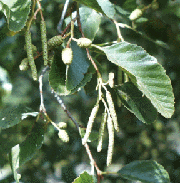Alnus Rubra and
|
Biology 585 Scanning Electron Microscope Professor: Dr. Darlene Southworth Southern Oregon University |
PURPOSE To obtain micrographs and supporting documentation to be used as an environmental education resource on the Internet and in the classroom. |
BACKGROUND While 78% of the air we breath is composed of stable, diatomic nitrogen (Stockley 1988), the vast majority of plants and animals require nitrogen but are not able to utilize it directly from Earth's atmosphere. Nitrogen is used by living things as a building block for most enzymes and must be available in chemically reactive forms which can be easily assimilated (Mauseth 1991). Industry synthesizes nitrate and ammonium, and both agrichemicals are used widely as fertilizers. However for every ton of available nitrogen produced in factories, nature contributes five tons to the biosphere. Lightening converts a significant amount of atmosphereic nitrogen into water soluble compounds, but it is the prokaryotes of the monera kingdom that do the majority of the nitrogen-fixing on Earth. Cyanobacteria, actinomycetes, and eubacteria fix some 130 million tons of nitrogen annually (Mauseth 1991). |
 Figure 1. Red Alder catkins. |
 Figure 2. The underside of a Alnus rubra leaf. Note the two tricombs and the open stomas. The atmospheric nitrogen gas which is fixed by Frankia is inspired via these stomas. |
The actinomycete Frankia alni lives in symbiosis with Alnus rubra (Red Alder), inhabiting root cells which swell to produce characteristic nodules. (Kaufman 1989) Frankia alni employs an enzyme complex, nitrogenase, to reduce atmospheric nitrogen (N2) to ammonia (NH4+). Frankia uses some of the nitrogen for it's own metabolic purposes, but a significant portion diffuses into nearby host protoplasm (Kaufman 1989). Alnus rubra is a shade intolerant hardwood species native to the Pacific Northwest. It is a seral species, one that pioneers areas laid waste by fire or logging. Usually succeeded by conifers, Alnus rubra is found as a climax species in some swamps. Alder is browsed by deer and elk, and grouse are known to eat budding leaves (Whitney 1989). |
web page authored by Bob Musgrove